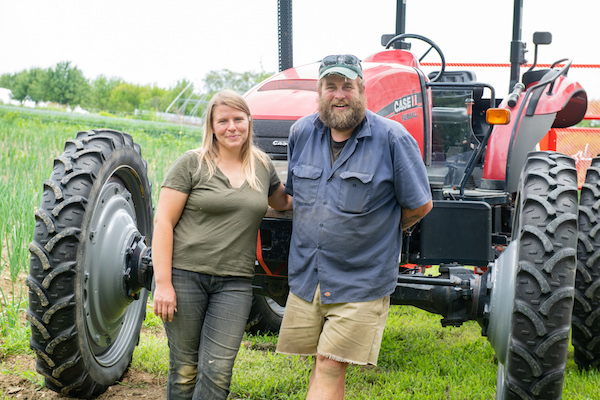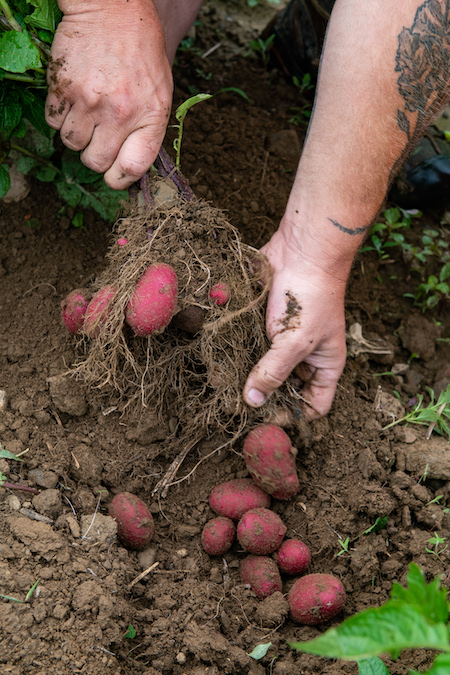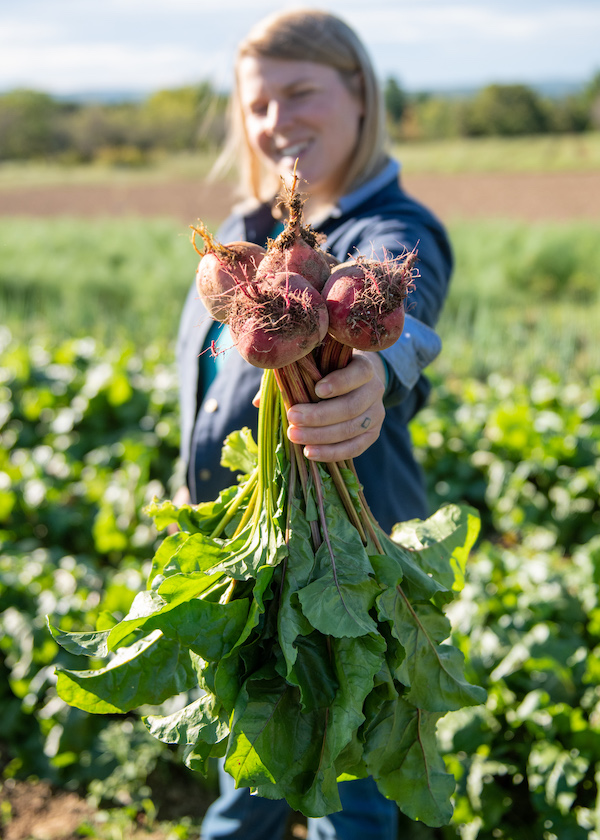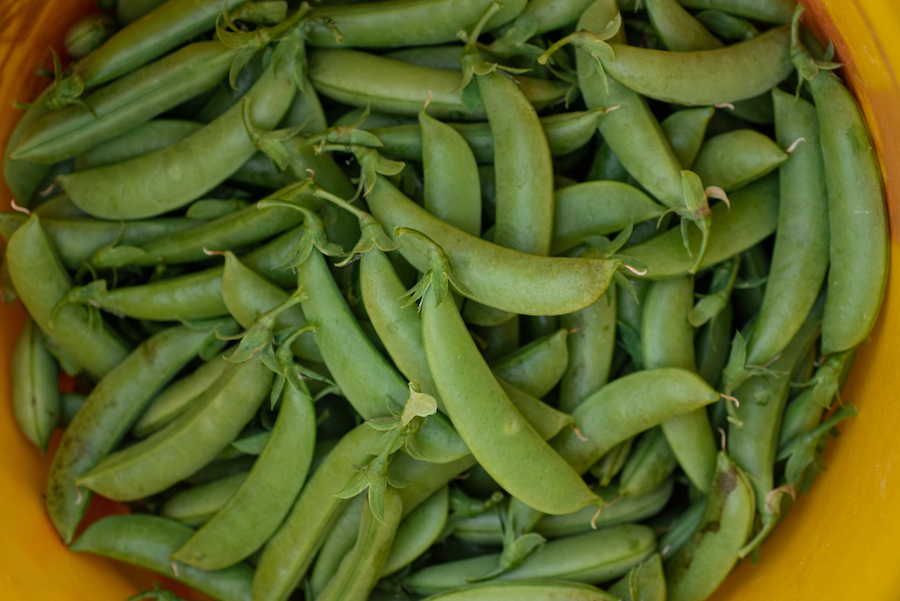How The Buckle Farm Streamlined Their Business for Profitability and Improved Their Wellbeing
By Jennifer Wilhelm
Husband and wife team Jim Buckle and Hannah Hamilton of The Buckle Farm worked “epically long days” to get their business up and running. Five years after starting their farm in Unity, Maine, they found themselves exhausted from twice-weekly trips to Boston and hauling food to the city for their 100-plus-member Community Supported Agriculture (CSA), wholesale accounts, restaurants and farmers’ markets. The duo was on the verge of burnout and knew that they needed to change their business model if they wanted to continue farming.

“We were working with a couple of misconceptions,” says Hamilton. “We felt like our best money was in Boston.” Though Buckle had developed strong relationships with customers in the city while farming there for several years, living over 200 miles north presented new challenges, not the least of which was losing dozens of hours each week to transportation and distribution.
In 2014, Hamilton and Buckle founded The Buckle Farm, a MOFGA-certified organic farm on 16 acres with additional leased fields down the road. At the start, they were growing mixed vegetables and herbs, and doing as much season extension as they could. They raised a small flock of chickens for eggs and pigs for pork; grew cut and edible flowers; ran a food booth with prepared food at the Common Ground Country Fair; raised retail seedlings for wholesale buyers; sold to 10 restaurants per season, mostly in Boston; ran a Boston-based summer vegetable CSA, with 120 members at its peak; and managed a smaller winter CSA, also in Boston.
They thought that diversity in their crop selection and diversity in markets would produce a vibrant sustainable farm. However, just a few years into their new farm business, they found themselves in “survival mode,” making short-term decisions that were not serving their long-term viability. Good Agricultural Practices (GAP) certification, a goal they aspired to achieve from the start to gain access to more wholesale markets, seemed way out of reach. They were spread thin.
With this business model, Hamilton and Buckle found themselves with high cash flow but low profitability. Winter jobs were a necessity. With little time to think about long-term solutions and even less time to rest and enjoy vacation, they were forced to reevaluate their business model. In 2019, they sought the guidance of loan officers, worked with FarmSmart, found support from their peers, and completed several grant applications.
This was a turning point for The Buckle Farm, one that moved them from survival mode into thriving mode or, as they now like to think of it, “artist mode versus craftsperson mode.”
“When we were starting out we were really lean. We didn’t have a lot of infrastructure on the farm. In survival mode, we had to be really creative. We were putting a ton of energy into making it work and we learned a ton about ourselves, our farm and our soil. We learned so much in those days. We were really good at improvising,” says Hamilton. For example, if a crop failed, they would shift their marketing strategy to bring that crop to a buyer. “Like baby onions!” says Hamilton. “They were a stunted crop, but to the right chef it’s exactly what they need.”

She was also harvesting mugwort, clover and goldenrod from the field margins and selling them to chefs in Boston as “Maine wildcrafted herbs.” She notes, “While we used it to the maximum in those days, that type of energy is limited.”
As craftspeople, they now have a slow, dedicated practice to farm planning. They are much more intentional about what they do and how they do it. They are more disciplined about how they treat their soil and how they plan for the long-term health of the farm.
“It took the energy and the productivity of artist mode to graduate to the craftsperson mode,” says Hamilton. “We wanted to save the energy we had left for our personal lives and personal projects.” That requires their farm to be a well-oiled machine. Hamilton and Buckle now work through a five-step decision-making process to determine whether to grow a specific crop. The first step is determining how they feel about the crop. They ask themselves if growing that crop is fun. “I care more about how we feel and what we are going through as people,” says Buckle. Considering their feelings and personal well-being was not part of the original business equation. Now, it’s the first factor Buckle and Hamilton consider when farm planning.
The next step in the decision-making process is focused on markets. They may enjoy growing potatoes, but do they have a market for them? What season is the crop harvested? How well does the crop store? Is the crop trendy or a staple? According to Buckle, “Onions are not trendy. If it’s a trend, I don’t have the time, the energy, the mechanics, or the feelings to get into the trend.”
If their responses are positive in the first two categories, they move on to steps three and four: considering if they have the proper management systems for that crop and what practices are required for growing that crop. Does the crop work with their current growing systems? Do they have the infrastructure to handle the harvest, washing and storage required? Onions may take a long time to grow, but when they are ready to be transplanted, winter squash seedlings take their place in the greenhouse, which is ideal for infrastructure and labor efficiency.
Lastly, they consider the bottom-line. Questions of cost are often overlooked in farming operations; it can be challenging and time consuming to determine how much each crop costs to grow. And yet, without these data, farmers cannot know if they are making or losing money. Understanding how much the crop costs to raise per bed foot, the highest and lowest prices on the market, the estimated annual gross income per bed foot, how much packaging and shipping cost, and what the delivery costs are is crucial to the economic viability of a farm.

At the end of the decision-making process, Hamilton and Buckle have a definitive yes or no answer, and they trust the outcome. “We’ve had some of our best results after managing these questions and taking appropriate risks to figure things out,” says Buckle. “To not grow everything, you have to take each component so seriously, or else you put yourself in a vulnerable situation.”
The major changes in their new business model focus on reducing diversity in the types of markets they sell into, moving from CSA and farmers’ markets to wholesale accounts; shifting from growing dozens of crops to just five staple crops (onions, potatoes, winter squash, beets and retail seedlings); and investing in infrastructure to reduce reliance on labor. Just three years after making these changes, they saw benefits to both their business and their personal lives. Profitability, efficiency, yields and soil health all increased substantially. Their relationships with buyers improved. Products were more consistent and, as a result, the amount of waste produced decreased, as did bottlenecks in production and harvest schedules. All of these improvements created a healthier work-life balance, allowing space for rest, recharge and community. They now have an easier and more accurate crop planning experience that includes long-term cash flow projections so they can think about how their current situation will affect their retirement, and in 2020, they achieved their long-term goal of GAP certification.
Some of the challenges Hamilton and Buckle experienced are not uncommon for new farmers (trying to grow everything and reach every market) and others, like discovering per- and polyfluoroalkyl substances (PFAS) contamination on their farm, can sink a ship. In 2022, PFAS contamination was found in their well water. Fortunately, it was not detected in the soil or crops, though they ceased production while waiting for test results. Because they had taken the time to step back and evaluate the business, they had the mental and emotional capacity to deal with the contamination issue.

The lessons Buckle and Hamilton learned can apply to farms of differing scopes and scales. Buckle advises farmers experiencing similar changes to “do what you believe is best for you and your farm, hammer out a planning process that feels right to you, don’t change too much at once, and take appropriate risks.” As with most businesses, there is always more to do and learn. Though they have met many of their personal and professional goals, Hamilton and Buckle set their sights high. They aim to increase profitability further, continue to improve soil health, form an LLC, and anticipate future climate and supply chain issues.
While no one can predict the future, the work Buckle and Hamilton continually do to plan for the possibilities at The Buckle Farm creates a more stable business model. One that puts them in a better position to weather the challenges that come their way. In the meantime, they have the space to step back and celebrate the many accomplishments they have achieved.
This article originally appeared in the spring 2023 issue of The Maine Organic Farmer & Gardener.
